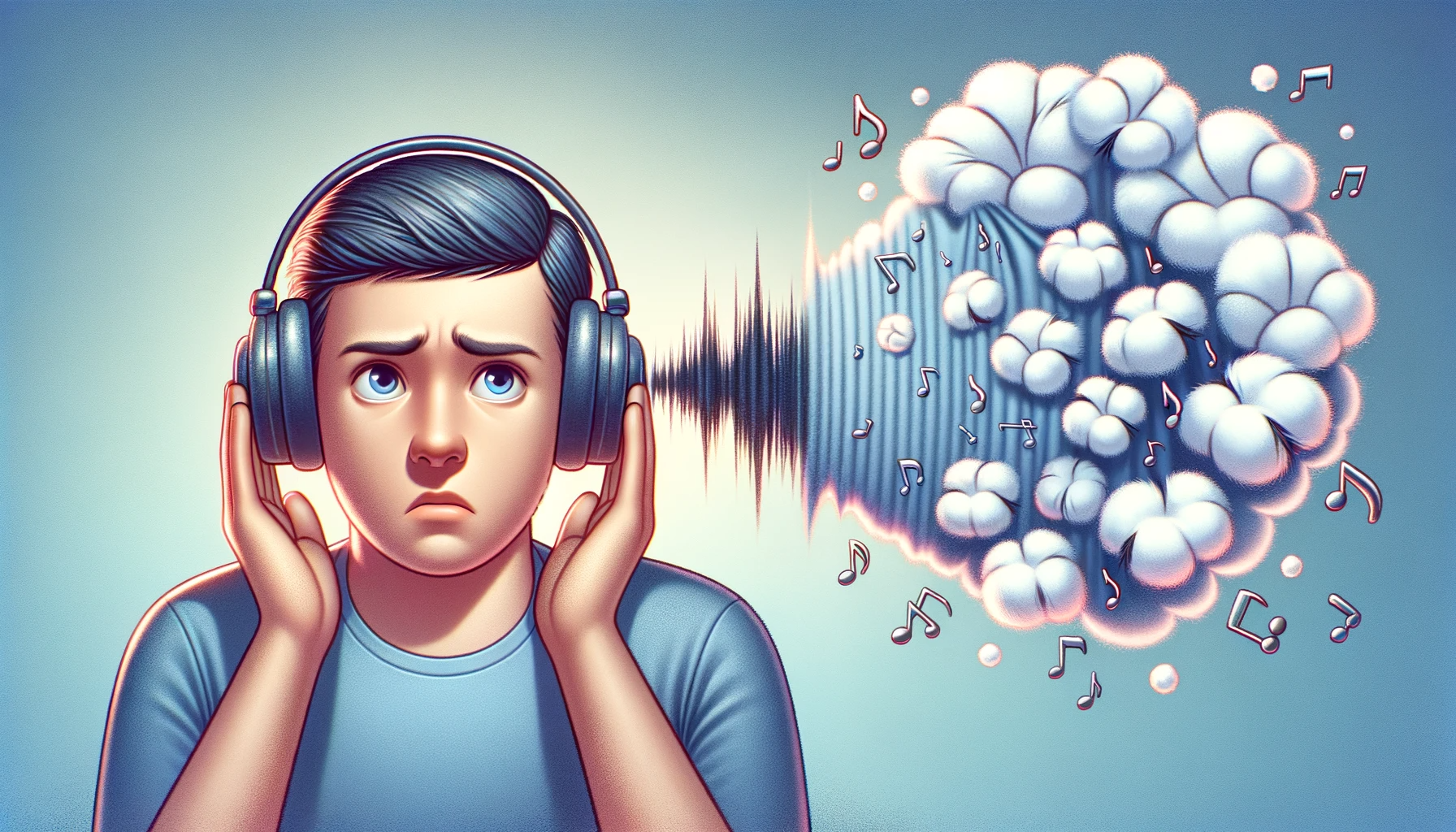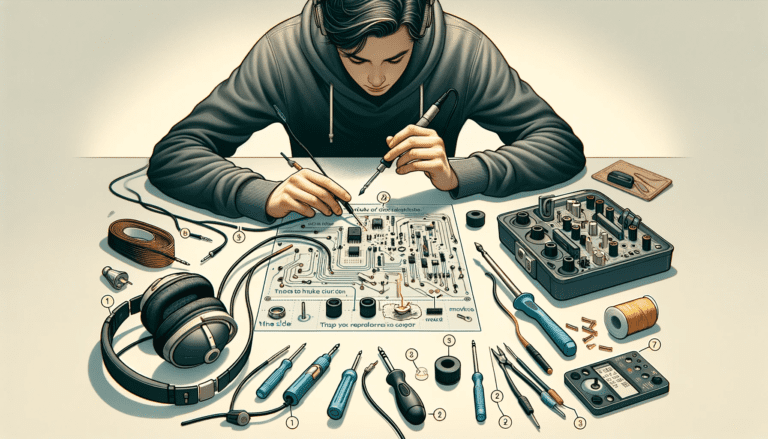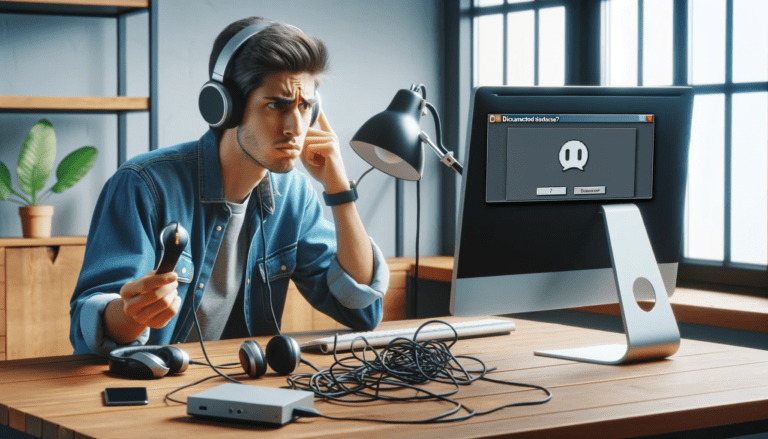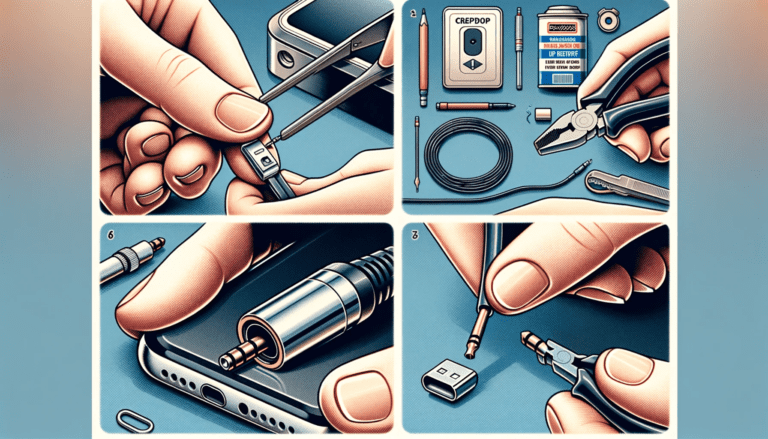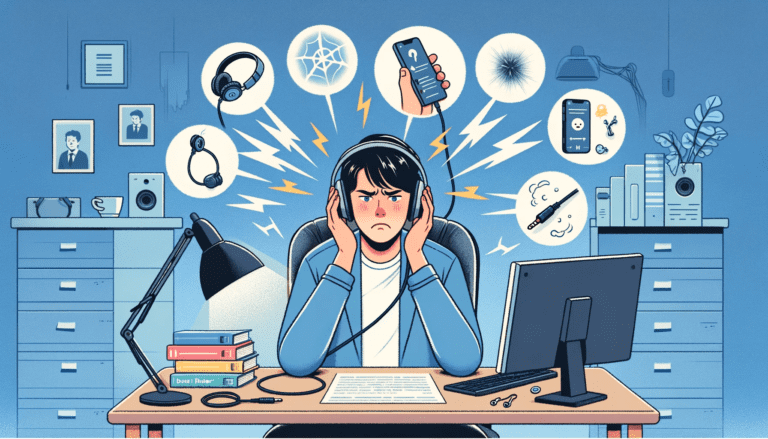Ever wondered, “Why do my headphones sound muffled?” It’s a frustration many face, and the answer isn’t always straightforward. Are you experiencing this common yet perplexing issue?
The reasons behind muffled headphone sound can vary widely, from dirt and debris lodged in your earbuds to a mismatch in audio settings. Often, it’s a simple case of wear and tear, but other times, a more complex technical issue might be at play. Understanding these causes is the first step toward crisp, clear sound.
Dive deeper into the world of audio clarity with us. We’ll explore everything from quick fixes to expert advice from renowned sound engineer Alex Smith. Get ready to uncover the secrets behind perfect sound as we lead you through a journey of troubleshooting and enlightenment. Your ears deserve nothing less.
Understanding the Science Behind Sound Transmission
First and foremost, let’s dip our toes into the mesmerizing world of sound transmission. It all seems so simple when you’re jamming to your favorite tunes, right? But there’s actually a whole lot of science involved behind that melodious audio reaching your ears.
Imagine sound as waves, and these waves travel in every direction from their source. When the waves touch an object – anything from objects around you to your eardrums – they cause those objects to vibrate. This vibration is what we perceive as sound. Fascinating, isn’t it?
Now, in the case of headphones, the sound is produced by drivers, which are little speakers located inside the earmuffs. These drivers convert the electric signals from your device into sound waves. The size, type, and quality of drivers play quite a significant role in how the sound turns out to be when it reaches you.
Moving forward, let’s take a quick look at the types of headphone drivers. There are five main types – dynamic, balanced armature, planar magnetic, electrostatic, and bone conduction drivers. Each works differently and offers unique sound characteristics.
- Dynamic Driver: The most common and versatile type. They produce sound by a mix of magnetism, electricity, and diaphragms.
- Balanced Armature Driver: These used by changing an electrostatic field. They deliver crisp sound but are pricey and usually seen in high-end headphones.
- Bone Conduction Driver: As the name suggests, these drivers carry the sound via bones. This allows users to hear the sound even without directly blocking the ear canal.
So, when you’re wondering why your headphones might sound muffled, the trouble may have something to do with these drivers. But it doesn’t just stop there. Other factors like your headphones’ condition, quality and even ear wax can all influence sound transmission. Over the next sections, we’ll deep dive into these factors to help you find and fix the root cause of your muffled headphone woes. You may read also the guide on Why are My Headphones Crackling
Decoding the Reasons: Why Your Headphones Sound Muffled
Ever wondered why your favorite pair of headphones suddenly started sounding less than terrific? While there are several potential explanations for the muffled sound, some more common reasons include physical damage to the headphones, blockage from earwax or debris, worn-out ear cushions, and outdated or incompatible software.
Firstly, physical damages such as a loose or broken wire, cracked speaker, or compromised sound chambers within your headphones can drastically impair their performance. These damages usually result from mishandling, dropping the headphones, or excessive strain on the wires. The sound might seem muffled because the audio signals are not being properly transmitted from the device to your ears.
Earwax or debris that has accumulated on the earbuds can also result in a muted, muffled audio experience. Even the tiniest amount of earwax or dust can block the tiny holes that transmit sound, leading to noticeably reduced audio clarity. Similarly, if your ear cushions are worn out or do not provide an airtight sound chamber around your ear, air and sound leakage could occur, causing a muffled sound.
Next up, incompatible or outdated software might be the invisible culprit behind your muffled audio. As most headphones nowadays rely on digital connections and software settings to function at their best, outdated or incompatible audio drivers could severely impact the sound quality.
Note: For wireless headphones, distance and obstructions between the audio source (like your phone or computer) and the headphones might also interfere with the sound quality, resulting in muffled sound.
Now that we’ve set the groundwork, let’s dig a little deeper into each reason. We’ll also provide some proven tips to maximize the performance and longevity of your headphones for an exceptional listening experience. Let’s dive in!
Identifying the Symptoms: Recognizing the Signs of Muffled Sound
Have you ever wondered why the tunes on your playlist just don’t sound as crisp and clear as they used to? If so, your headphones might be experiencing muffled sound problems. Recognizing the signs of this issue is the first step toward fixing it.
Muffled sound could be described as when your music or audio feels “heavy”, lacking in clarity, or as if it is shrouded with an invisible veil. It’s that dull undertone that suppresses the real crispness and depth of your music.
Here are a few symptoms that help you identify if your headphones are indeed affected by muffled sound:
- Tonal Imbalance: Typically, music should feel balanced across the lows, mids, and highs. Muffled sounds often skew this balance, causing some elements to dominate others.
- Reduced Vibrancy: When the sound is muffled, you may notice a decrease in the brightness or liveliness of your music. Instruments and vocals might lose their vibrancy and feel less energetic.
- Distortion: Another characteristic of muffled sound is distortion. This may manifest as unwanted noises and feedback during playback.
- Low Volume: If your audio sounds unusually quiet even at high volume settings, this could indicate a muffled sound problem. You might find yourself constantly turning the volume up without much improvement.
Getting to know these symptoms is an important part of the process. Because, once identified, you’re one step closer to restoring your headphones to their crystal clear glory!
So, now that we have identified the problem, let’s dive deeper into what might be causing these issues in the ‘Decoding the Reasons: Why Your Headphones Sound Muffled’ section.
Deep Dive: The Impact of Audio Quality on Your Headphones
Audio quality, as you may guess, greatly influences the sound you perceive through your headphones. Poor audio can certainly make your headphones sound muffled. But what exactly do we mean by audio quality? Let’s drill down a bit deeper into this topic.
Audio quality, quite simply, refers to the precision with which sound is reproduced. A high-quality audio file allows your headphones to truly shine, permitting you to detect each note, hear subtle background elements, and immerse yourself in the aural environment. On the other hand, a poor-quality audio file can make even the highest-end headphones produce unsatisfactory, muffled sound.
Female vocals, for instance, greatly rely on high-frequency sounds, so a reduced audio quality can make such vocals sound muted or distant. Other subtle aspects, such as the timbre or texture of a musical instrument, can also be lost with a decrease in sound quality.
- Bit rate describes how much data is stored per second of audio. A higher bit rate corresponds to more detail and thus, better quality.
- The sample rate represents how many times per second the sound is sampled. Again, a higher number indicates higher quality.
- Compression can reduce file size but can compromise sound quality. Lossless compression retains the quality, while lossy compression discards data.
To truly evaluate whether your headphones are responsible for the muffled sound, try playing a high-quality audio file or streaming from a service known for its quality. If your headphones still sound muffled, it’s probably not the audio quality causing the issue. You may read the guide on Why Does My Headphones Sound Low
Examining the Role of Ear Wax in Muffled Sounds
Ever wonder why your favorite tunes or that important video conference sound less than perfect through your headphones? Despite maintaining your device well over time, you may not realize that your own ears contribute to the muffled sound! Yes, you read that right, it’s the ear wax we’re talking about.
Ear wax, also known scientifically as cerumen, plays a critical role in our body by protecting the ear canal from foreign particles like dust and tiny creatures. However, when it comes to delivering crisp sound through headphones, an excess of ear wax can become an obstacle. But how does this seemingly inconspicuous substance play such a major role? Let’s unpack this.
The physical presence of ear wax can interfere with the flow of sound waves from your headphones into your ears. This impact can be likened to a wet blanket thrown over a speaker – the sound becomes more subdued, losing its clarity and fidelity. When your ear canal is blocked by wax, the result is often a dull or muffled sound coming from your headphones.
Don’t panic just yet though! It’s important to note that a little ear wax is not only normal but also beneficial for your ear health. It’s when the wax accumulates to the point where it impedes the flow of sound that it can become an issue.
Moreover, when you push your earbuds into your ear canal, you may inadvertently push the wax further in. Over time, this can form a hard mass that not only affects your hearing through headphones but can also lead to discomfort or even, in severe cases, pain.
So how can one deal with this wax issue without harming the delicate internal structure of the ears? Cleaning your ears regularly and carefully is the way to go. You need to ensure that your ear canals are clean but remember, excessive cleaning may also lead to dry and itchy ear canals. We recommend a balance between cleanliness and maintaining the natural wax needed to protect your ears.
In the next section, we will walk you through a safe and effective method of cleaning your headphones. Stick with us to gain some valuable insight!
Quick Fixes: Simple Steps to Improve Sound Quality
Ah, sound quality, it’s a deal-breaker, isn’t it? Like a symphony lost in a snowstorm, when your headphones emit muffled sound, it’s grave news. But don’t fret! There are, indeed, some quick and easy ways for you to rectify the situation and bring the sweet harmony back into your life.
Firstly, check the headphone jack. A loose plug has been the culprit in many muffled sound cases. Simply unplugging and securely re-plugging the headphones can often do the trick.
Then, inspect for obvious physical damage. Headphones are quite delicate. A bent connector, frayed wires, or a crushed earbud cover could be hindering audio transmission. If you spot any physical damage, it could be time for a repair or even an upgrade if the issue is substantial.
What if everything looks good? Well, if you’ve ruled out physical damage, the next step is to explore the settings. Is noise cancellation switched on? Noise-canceling headphones can often take the life out of softer or more intricate audio sequences resulting in a muffled sound. Turning it off can help, particularly when you’re listening in a quiet environment.
Another setting you might want to adjust is your equalization. You can tweak these settings on your mobile device, computer, or audio player. Push the high-end frequencies and see if it makes a difference. Remember, a badly balanced equalizer can push certain frequencies to the back, causing a muffled audio experience.
Next, remember this, volume does matter, but in moderation. If you consistently listen to your audio at high volume, you risk damaging the tiny speakers within your headphones, which can eventually lead to distorted and muffled sound.
Finally, ensure software compatibility. Mismatched hardware and software can choke your headphones’ ability to produce clear sound, so confirm that your audio device is compatible with your headphones.
Don’t let muffled headphones silence your symphony of sound. Employ these quick fixes and you’ll be back to optimal audio in no time!
A Step-by-Step Guide: How to Clean Your Headphones
Occasionally, your headphones may sound muffled due to the build-up of dirt and dust. Cleaning your headphones not only enhances the sound quality but also prolongs their lifespan. So, let’s walk you through a simple, careful method to get those headphones squeaky clean and sounding superb again.
Step 1: Gather your cleaning supplies
You’ll need a soft cloth, cotton swabs, rubbing alcohol or a gentle cleaner, and a toothpick. Please ensure your cleaning materials are of good quality, so you don’t inadvertently inflict damage during your careful cleaning endeavor.
Step 2: Unplug and power down
Always make sure your headphones are not connected to any device and are powered down. This not only prevents possible electric shocks but also protects your devices from accidental water damage.
Step 3: Wipe down the headphones
Using the soft, slightly dampened cloth, wipe down the exterior of your headphones to eliminate any dust, dirt, or loose particles. Be gentle as you don’t want to scrape off any coating or damage any of the parts.
Step 4: Clean the ear pads
Detachable ear pads can usually be cleaned with a bit of soap and water. Non-detachable ones, meanwhile, can be cleaned with a cloth dampened with a mild cleaning solution. Ensure all components are fully dry before reassembling to avoid dampness lingering in your headphones or earbuds.
Step 5: Detailing
Use the cotton swabs dipped in rubbing alcohol to clean in and around any crevices or buttons. For stubborn grime in hard-to-reach areas, a toothpick can be used carefully. Just remember to be gentle to avoid damaging your device.
Step 6: Dry thoroughly
Before using your headphones again, make sure they’re completely dry. This protects their inner workings and your devices from potential water damage. Give them a good 24 hours just to be safe.
Heads up! Cleaning your headphones regularly can maintain their performance and ensure the longevity of the device. A little maintenance goes a long way in preserving sound quality.
Finally, remember not to overdo it. Cleaning your headphones too often or using harsh cleaners can damage them. A careful cleaning every few months should keep your headphones sounding their best!
Embracing Tech: Software Updates and Sound Quality
Believe it or not, the reason behind your muffled audio may not be a physical defect but rather outdated software! Yes, your headphone’s sound quality can be affected by the firmware and software it runs on. If you’re experiencing poor sound quality, it might be time to give your tech a little TLC with some updates.
What is Firmware?
In simpler terms, firmware is the operating software embedded into your headphones or the device it connects to. It’s responsible for the basic functions of your device, including the way sound is transmitted and received.
Impact of Outdated Firmware or Software
Like any technology, the software on your headphones or your listening devices needs to be updated regularly. When an update occurs, improvements are often made to the performance and functioning of the tech. If your firmware or software is outdated, it may cause sound distortions such as muffled audio. This is because older software versions may not be optimized for the latest audio compression algorithms, leading to a loss in sound quality.
Updating Your Software
- Check the manufacturer’s website or your device’s settings to see if there are any software or firmware updates available.
- Follow the prompts to download and install any updates.
- Once the updates have been successfully installed, reboot your device.
- Test your headphones again to see if the sound quality has improved.
Remember, the process may vary depending on your headphone’s make and model, or the device you’re connecting it to. Always rely on official updates from the manufacturer to avoid any potential glitches.
Checking your Audio Software Settings
Your device’s audio software settings can also impact the sound quality. Check to make sure that your equalizer settings haven’t been adjusted to overly favor bass or treble, both of which can result in muffled sound. Also, ensure that any surround sound features are properly configured. Every small tweak can turn your audio from muffled to crystal clear.
In conclusion, don’t overlook the importance of staying up-to-date with your tech. If you’ve tried everything else, checking for software updates might just save you from unnecessary headphone replacement! You may check also Why Do My Headphones Keep Cutting Out
Inside the Sound Chamber: The Impact of Ear Cushion Material
When you’re dealing with the issue of muffled sound in headphones, you may not think it’s important, but believe me, the material of your ear cushions most certainly figures into the equation. Yes, that’s right! The plush padding that feels oh-so-comfortable can also impact the overall sound quality.
For starters, let’s understand why ear cushions matter in the first place. Ear cushions not only provide comfort but also create a seal around your ears. This sealing helps channel sound directly into your ears and prevents it from escaping, which in turn enhances sound quality. However, if the material used in the cushions is of poor quality, or they are worn down over time, the seal can become less effective, causing sounds to leak and make your headphones sound muffled.
In an attempt to illustrate the different types of ear cushion materials and their impact on your headphones’ sound, take a look at the table below:
| Material | Sound Quality Impact |
|---|---|
| Leather | Leather offers excellent noise isolation and enhancement of bass. However, too much isolation can sometimes muffle other frequencies. |
| Fabric | Provides a natural, open sound quality but doesn’t isolate background noise as well as leather. This can lead to a less immersive experience but also less muffled audio. |
| Velour | Velour is comfortable and heats less than leather, providing a decent mix of openness and isolation. But just like fabric, it can let in more ambient sounds. |
However, it’s not just the kind of material that influences your sound. The condition of the material matters too. Worn-out, torn, or flimsy ear cushions can significantly bring down the quality of sound, making it sound distorted, unclear, or yes, muffled. So, it’s essential to keep your ear cushions in as tiptop condition as you can.
One size fits all solutions don’t always work in the world of sound. There’ll be trade-offs no matter what material you choose for your ear cushions. But knowing what causes the sound to behave the way it does, might give you a better idea of how to troubleshoot and fix your muffled headphone predicament.
Do remember, sound quality is an incredibly personal and subjective thing. What works for one person might not work for another. It might also be a good idea to try out different materials until you find your perfect match. Here’s to crystal clear sound!
Expert Tips: How to Prevent Future Muffled Audio Issues
Proactively safeguarding your headphones against future muffled audio issues isn’t just smart—it’s essential. While all types of headphones are susceptible to degradation over time, following these expert tips will help you stave off audio issues for as long as possible.
- Regular Cleaning: Dust, debris, or ear wax can obstruct the path that sound travels through, leading to muffled audio. Regularly clean your headphones, ear tips, or earbuds with a soft, dry cloth. Refer to the manufacturer’s instructions for proper cleaning.
- Proper Storage: When not in use, always store your headphones in a clean, dry place. Using a protective case can especially aid in reducing dust and dirt accumulation. Avoid leaving your headphones out, where they may be exposed to additional dirt or damage.
- Handle with Care: While headphones are designed to be durable, excessive pulling, twisting, or dropping can damage internal components, leading to audio quality reduction. Handle your headphones with care to ensure they last longer.
- Use Quality Audio Files: Muffled sound can sometimes result from low-quality audio files. If you can, try to use high-bitrate, uncompressed audio files such as FLAC or ALAC instead of MP3.
- Regular Software Updates: Keeping your device’s software up to date, whether it’s your smartphone or your headphones’ firmware, helps in maintaining the best possible audio quality.
But what happens if, despite all preventive measures, your headphones still sound muffled? Remember, it’s not the end of the world. There is always a solution for fixing this issue. And even if in the worst-case scenario, your headphones are beyond repair, isn’t it a perfect excuse to treat yourself with a new pair, with even better audio quality? Do ensure though to handle them with care and love.
Conclusion
In conclusion, muffled sound from your headphones can be traced to various factors ranging from physical concerns, like earwax buildup and ear cushion material, to technical issues, such as outdated firmware or incorrect audio settings.
Understanding the science of sound enables you to identify the symptoms of compromised audio quality. Luckily, most muffled sound concerns can be resolved with relative ease through regular cleaning, correct software updates, and small tweaks in your audio settings.
Keep in mind, that preventing future audio issues requires consistent care and attention toward your audio devices. So, armed with this knowledge, you are now empowered to not only recognize issues when they occur but also take effective steps to rectify and prevent them, ensuring an immersive audio experience.
FAQs (Frequently Asked Questions)
1. My Bluetooth Headphones Sound Muffled, What Could Be the Issue?
If your bluetooth headphones are producing muffled or distorted sound, the problem could be related to the wireless connection or sound settings on your device. Firstly, ensure that your headphones are fully charged and paired properly with your device. If the issue persists, try disabling and re-enabling the Bluetooth connection and adjusting the audio settings on your device to see if this resolves the problem.
2. How Can I Fix Muffled Sound Issues with My Wired Headphones?
If your wired headphones are producing muffled sounds when you listen to music, it could be due to a fault in the headphone wires or the audio settings on your device. Try testing the headphones with another device to see if the issue persists. If the sound is still muffled or distorted, consider replacing the headphone wires or adjusting the audio settings on your device to improve the sound quality.
3. I have a New Pair of Headphones and the Sound is Muffled. What is the Problem?
If a new pair of headphones is producing a muffled sound, it may indicate a fault with the quality of your headphones or a compatibility issue with your device. Check the audio settings on your device and ensure that the headphones are properly connected. If the sound is clear when using a different device, the issue may be related to the compatibility or quality of the headphones.

